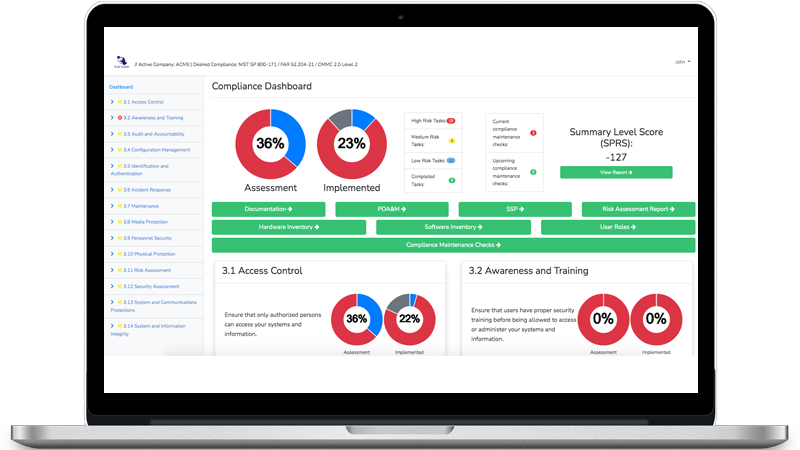
Book a Discovery Call
- How long does it take to become compliant?
- How much does it cost to become compliant?
- See a demo of our solution

AC.L2-3.1.14 – Route remote access via managed access control points.
This control comes from NIST SP 800-171 REV.2 / CMMC 2.0 Level 2.
This control requires that all remote access into your environment be funneled through managed access control points—typically firewalls, VPN concentrators, or secure gateways—so you can centrally enforce security, monitor activity, and reduce the chance of data exposure. In practice, that means identifying and implementing the access control points you manage, and ensuring every remote connection (users, admins, vendors) is routed through them rather than directly to internal systems. Doing so increases visibility and control over remote connections and helps protect sensitive information.
Document a Remote Access Policy that defines who may connect remotely, which methods are approved (e.g., VPN, secure gateway), and that all remote sessions must traverse managed access control points. Include procedures for onboarding/offboarding remote users and vendors, device authorization (corporate vs. BYOD), admin access via jump hosts, configuration/change management for firewalls and VPNs, periodic access reviews, logging and retention standards, and incident response steps for suspicious remote activity. Require multi-factor authentication and prohibit direct Internet exposure of management interfaces (e.g., RDP/SSH) to internal assets.
A 120-employee engineering firm discovers through an external scan that a branch server has RDP exposed to the Internet and several contractors connect via ad hoc tools. The IT manager standardizes on a single VPN concentrator at headquarters behind the firewall and disables all direct remote services at branch sites. All employees and contractors must now use the corporate VPN with MFA, and remote admin tasks happen only through a hardened RDP gateway on a management VLAN. The firewall enforces policies that limit VPN users to specific application subnets; contractors can only reach a file share and ticketing system, and only during business hours. Logs from the VPN and gateway feed into a centralized log system with alerts for failed logins and access from new countries. During the first month, an alert flags repeated failed logins for a former contractor; the account is promptly disabled, and the access review procedure is updated to ensure contractor accounts are closed on project completion.
Meeting AC.L2-3.1.14 is about centralizing and controlling every remote connection through managed access control points you configure, monitor, and trust. A clear remote access policy, disciplined onboarding/offboarding, and change control set expectations, while a consolidated VPN or secure gateway with MFA, least-privilege network rules, hardened admin paths, and robust logging delivers the technical enforcement. Together, these measures provide visibility, reduce attack surface, and ensure remote access adheres to your security standards.
Quick & Simple
Whether you need to meet and maintain your compliance requirements, help your clients meet them, or verify supplier compliance we have the expertise and solution for you
We typically reply within minutes